Yanjing Li
Squeeze10-LLM: Squeezing LLMs' Weights by 10 Times via a Staged Mixed-Precision Quantization Method
Jul 24, 2025Abstract:Deploying large language models (LLMs) is challenging due to their massive parameters and high computational costs. Ultra low-bit quantization can significantly reduce storage and accelerate inference, but extreme compression (i.e., mean bit-width <= 2) often leads to severe performance degradation. To address this, we propose Squeeze10-LLM, effectively "squeezing" 16-bit LLMs' weights by 10 times. Specifically, Squeeze10-LLM is a staged mixed-precision post-training quantization (PTQ) framework and achieves an average of 1.6 bits per weight by quantizing 80% of the weights to 1 bit and 20% to 4 bits. We introduce Squeeze10LLM with two key innovations: Post-Binarization Activation Robustness (PBAR) and Full Information Activation Supervision (FIAS). PBAR is a refined weight significance metric that accounts for the impact of quantization on activations, improving accuracy in low-bit settings. FIAS is a strategy that preserves full activation information during quantization to mitigate cumulative error propagation across layers. Experiments on LLaMA and LLaMA2 show that Squeeze10-LLM achieves state-of-the-art performance for sub-2bit weight-only quantization, improving average accuracy from 43% to 56% on six zero-shot classification tasks--a significant boost over existing PTQ methods. Our code will be released upon publication.
CCExpert: Advancing MLLM Capability in Remote Sensing Change Captioning with Difference-Aware Integration and a Foundational Dataset
Nov 18, 2024



Abstract:Remote Sensing Image Change Captioning (RSICC) aims to generate natural language descriptions of surface changes between multi-temporal remote sensing images, detailing the categories, locations, and dynamics of changed objects (e.g., additions or disappearances). Many current methods attempt to leverage the long-sequence understanding and reasoning capabilities of multimodal large language models (MLLMs) for this task. However, without comprehensive data support, these approaches often alter the essential feature transmission pathways of MLLMs, disrupting the intrinsic knowledge within the models and limiting their potential in RSICC. In this paper, we propose a novel model, CCExpert, based on a new, advanced multimodal large model framework. Firstly, we design a difference-aware integration module to capture multi-scale differences between bi-temporal images and incorporate them into the original image context, thereby enhancing the signal-to-noise ratio of differential features. Secondly, we constructed a high-quality, diversified dataset called CC-Foundation, containing 200,000 image pairs and 1.2 million captions, to provide substantial data support for continue pretraining in this domain. Lastly, we employed a three-stage progressive training process to ensure the deep integration of the difference-aware integration module with the pretrained MLLM. CCExpert achieved a notable performance of $S^*_m=81.80$ on the LEVIR-CC benchmark, significantly surpassing previous state-of-the-art methods. The code and part of the dataset will soon be open-sourced at https://github.com/Meize0729/CCExpert.
P4Q: Learning to Prompt for Quantization in Visual-language Models
Sep 26, 2024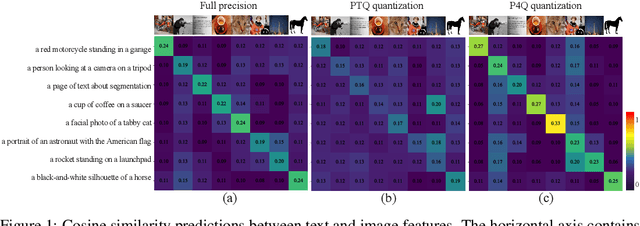
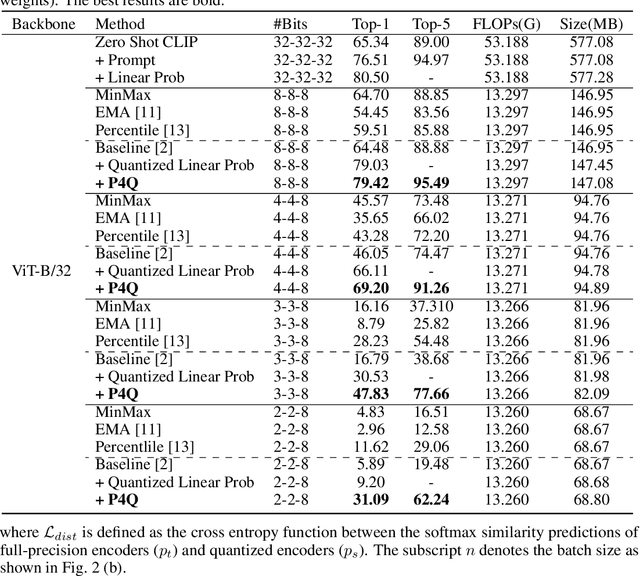
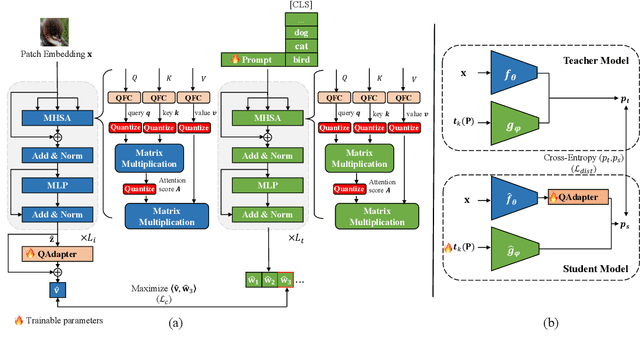
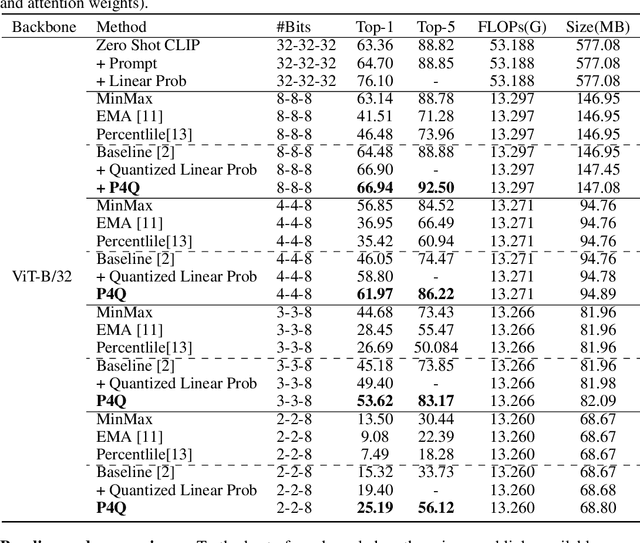
Abstract:Large-scale pre-trained Vision-Language Models (VLMs) have gained prominence in various visual and multimodal tasks, yet the deployment of VLMs on downstream application platforms remains challenging due to their prohibitive requirements of training samples and computing resources. Fine-tuning and quantization of VLMs can substantially reduce the sample and computation costs, which are in urgent need. There are two prevailing paradigms in quantization, Quantization-Aware Training (QAT) can effectively quantize large-scale VLMs but incur a huge training cost, while low-bit Post-Training Quantization (PTQ) suffers from a notable performance drop. We propose a method that balances fine-tuning and quantization named ``Prompt for Quantization'' (P4Q), in which we design a lightweight architecture to leverage contrastive loss supervision to enhance the recognition performance of a PTQ model. Our method can effectively reduce the gap between image features and text features caused by low-bit quantization, based on learnable prompts to reorganize textual representations and a low-bit adapter to realign the distributions of image and text features. We also introduce a distillation loss based on cosine similarity predictions to distill the quantized model using a full-precision teacher. Extensive experimental results demonstrate that our P4Q method outperforms prior arts, even achieving comparable results to its full-precision counterparts. For instance, our 8-bit P4Q can theoretically compress the CLIP-ViT/B-32 by 4 $\times$ while achieving 66.94\% Top-1 accuracy, outperforming the learnable prompt fine-tuned full-precision model by 2.24\% with negligible additional parameters on the ImageNet dataset.
A Multi-Grained Symmetric Differential Equation Model for Learning Protein-Ligand Binding Dynamics
Feb 01, 2024Abstract:In drug discovery, molecular dynamics (MD) simulation for protein-ligand binding provides a powerful tool for predicting binding affinities, estimating transport properties, and exploring pocket sites. There has been a long history of improving the efficiency of MD simulations through better numerical methods and, more recently, by utilizing machine learning (ML) methods. Yet, challenges remain, such as accurate modeling of extended-timescale simulations. To address this issue, we propose NeuralMD, the first ML surrogate that can facilitate numerical MD and provide accurate simulations in protein-ligand binding. We propose a principled approach that incorporates a novel physics-informed multi-grained group symmetric framework. Specifically, we propose (1) a BindingNet model that satisfies group symmetry using vector frames and captures the multi-level protein-ligand interactions, and (2) an augmented neural differential equation solver that learns the trajectory under Newtonian mechanics. For the experiment, we design ten single-trajectory and three multi-trajectory binding simulation tasks. We show the efficiency and effectiveness of NeuralMD, with a 2000$\times$ speedup over standard numerical MD simulation and outperforming all other ML approaches by up to 80% under the stability metric. We further qualitatively show that NeuralMD reaches more stable binding predictions compared to other machine learning methods.
SySMOL: A Hardware-software Co-design Framework for Ultra-Low and Fine-Grained Mixed-Precision Neural Networks
Nov 23, 2023Abstract:Recent advancements in quantization and mixed-precision techniques offer significant promise for improving the run-time and energy efficiency of neural networks. In this work, we further showed that neural networks, wherein individual parameters or activations can take on different precisions ranging between 1 and 4 bits, can achieve accuracies comparable to or exceeding the full-precision counterparts. However, the deployment of such networks poses numerous challenges, stemming from the necessity to manage and control the compute/communication/storage requirements associated with these extremely fine-grained mixed precisions for each piece of data. There is a lack of existing efficient hardware and system-level support tailored to these unique and challenging requirements. Our research introduces the first novel holistic hardware-software co-design approach for these networks, which enables a continuous feedback loop between hardware design, training, and inference to facilitate systematic design exploration. As a proof-of-concept, we illustrate this co-design approach by designing new, configurable CPU SIMD architectures tailored for these networks, tightly integrating the architecture with new system-aware training and inference techniques. We perform systematic design space exploration using this framework to analyze various tradeoffs. The design for mixed-precision networks that achieves optimized tradeoffs corresponds to an architecture that supports 1, 2, and 4-bit fixed-point operations with four configurable precision patterns, when coupled with system-aware training and inference optimization -- networks trained for this design achieve accuracies that closely match full-precision accuracies, while compressing and improving run-time efficiency of the neural networks drastically by 10-20x, compared to full-precision networks.
SIMD Dataflow Co-optimization for Efficient Neural Networks Inferences on CPUs
Oct 03, 2023Abstract:We address the challenges associated with deploying neural networks on CPUs, with a particular focus on minimizing inference time while maintaining accuracy. Our novel approach is to use the dataflow (i.e., computation order) of a neural network to explore data reuse opportunities using heuristic-guided analysis and a code generation framework, which enables exploration of various Single Instruction, Multiple Data (SIMD) implementations to achieve optimized neural network execution. Our results demonstrate that the dataflow that keeps outputs in SIMD registers while also maximizing both input and weight reuse consistently yields the best performance for a wide variety of inference workloads, achieving up to 3x speedup for 8-bit neural networks, and up to 4.8x speedup for binary neural networks, respectively, over the optimized implementations of neural networks today.
Representation Disparity-aware Distillation for 3D Object Detection
Aug 20, 2023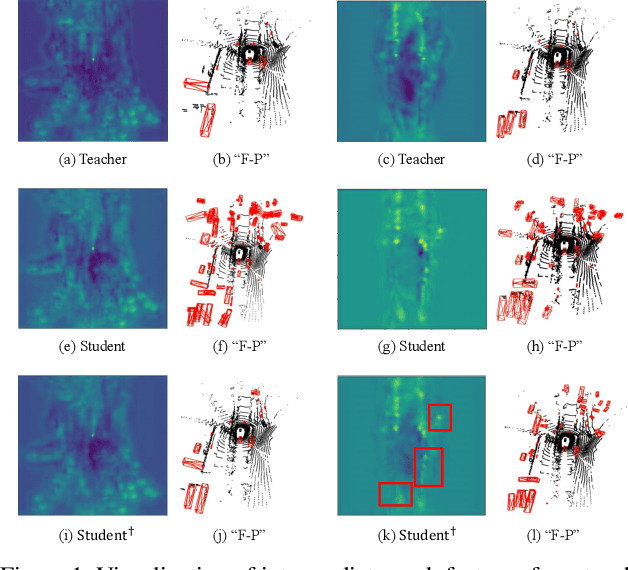
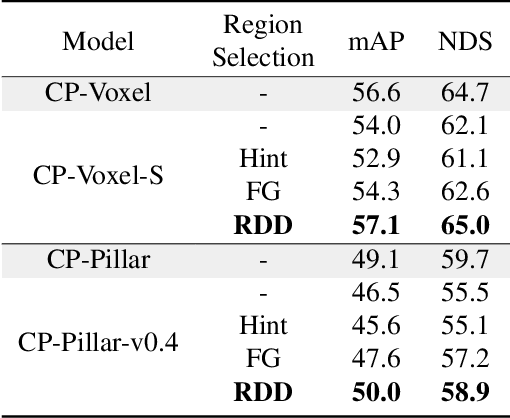
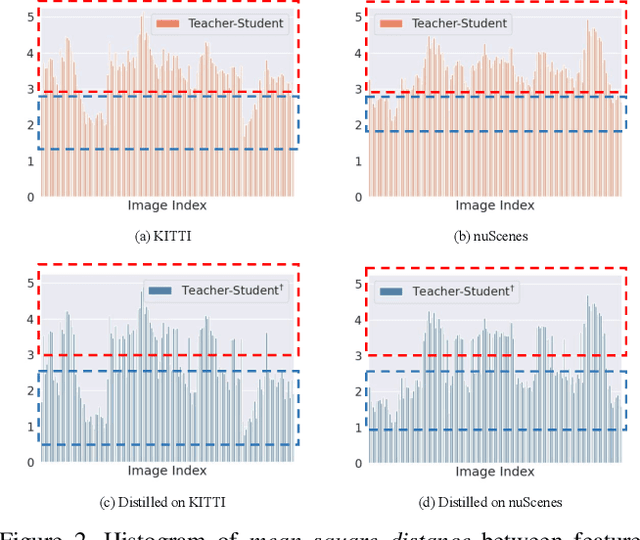
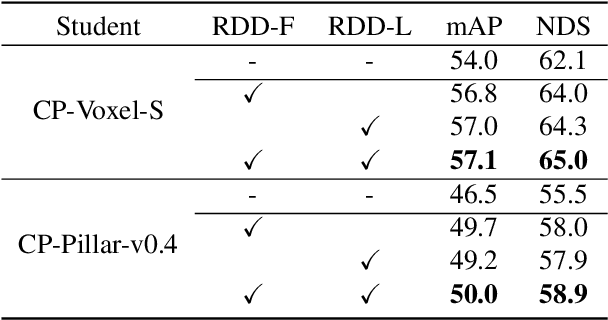
Abstract:In this paper, we focus on developing knowledge distillation (KD) for compact 3D detectors. We observe that off-the-shelf KD methods manifest their efficacy only when the teacher model and student counterpart share similar intermediate feature representations. This might explain why they are less effective in building extreme-compact 3D detectors where significant representation disparity arises due primarily to the intrinsic sparsity and irregularity in 3D point clouds. This paper presents a novel representation disparity-aware distillation (RDD) method to address the representation disparity issue and reduce performance gap between compact students and over-parameterized teachers. This is accomplished by building our RDD from an innovative perspective of information bottleneck (IB), which can effectively minimize the disparity of proposal region pairs from student and teacher in features and logits. Extensive experiments are performed to demonstrate the superiority of our RDD over existing KD methods. For example, our RDD increases mAP of CP-Voxel-S to 57.1% on nuScenes dataset, which even surpasses teacher performance while taking up only 42% FLOPs.
DCP-NAS: Discrepant Child-Parent Neural Architecture Search for 1-bit CNNs
Jun 27, 2023Abstract:Neural architecture search (NAS) proves to be among the effective approaches for many tasks by generating an application-adaptive neural architecture, which is still challenged by high computational cost and memory consumption. At the same time, 1-bit convolutional neural networks (CNNs) with binary weights and activations show their potential for resource-limited embedded devices. One natural approach is to use 1-bit CNNs to reduce the computation and memory cost of NAS by taking advantage of the strengths of each in a unified framework, while searching the 1-bit CNNs is more challenging due to the more complicated processes involved. In this paper, we introduce Discrepant Child-Parent Neural Architecture Search (DCP-NAS) to efficiently search 1-bit CNNs, based on a new framework of searching the 1-bit model (Child) under the supervision of a real-valued model (Parent). Particularly, we first utilize a Parent model to calculate a tangent direction, based on which the tangent propagation method is introduced to search the optimized 1-bit Child. We further observe a coupling relationship between the weights and architecture parameters existing in such differentiable frameworks. To address the issue, we propose a decoupled optimization method to search an optimized architecture. Extensive experiments demonstrate that our DCP-NAS achieves much better results than prior arts on both CIFAR-10 and ImageNet datasets. In particular, the backbones achieved by our DCP-NAS achieve strong generalization performance on person re-identification and object detection.
Symmetry-Informed Geometric Representation for Molecules, Proteins, and Crystalline Materials
Jun 15, 2023Abstract:Artificial intelligence for scientific discovery has recently generated significant interest within the machine learning and scientific communities, particularly in the domains of chemistry, biology, and material discovery. For these scientific problems, molecules serve as the fundamental building blocks, and machine learning has emerged as a highly effective and powerful tool for modeling their geometric structures. Nevertheless, due to the rapidly evolving process of the field and the knowledge gap between science (e.g., physics, chemistry, & biology) and machine learning communities, a benchmarking study on geometrical representation for such data has not been conducted. To address such an issue, in this paper, we first provide a unified view of the current symmetry-informed geometric methods, classifying them into three main categories: invariance, equivariance with spherical frame basis, and equivariance with vector frame basis. Then we propose a platform, coined Geom3D, which enables benchmarking the effectiveness of geometric strategies. Geom3D contains 16 advanced symmetry-informed geometric representation models and 14 geometric pretraining methods over 46 diverse datasets, including small molecules, proteins, and crystalline materials. We hope that Geom3D can, on the one hand, eliminate barriers for machine learning researchers interested in exploring scientific problems; and, on the other hand, provide valuable guidance for researchers in computational chemistry, structural biology, and materials science, aiding in the informed selection of representation techniques for specific applications.
Bi-ViT: Pushing the Limit of Vision Transformer Quantization
May 21, 2023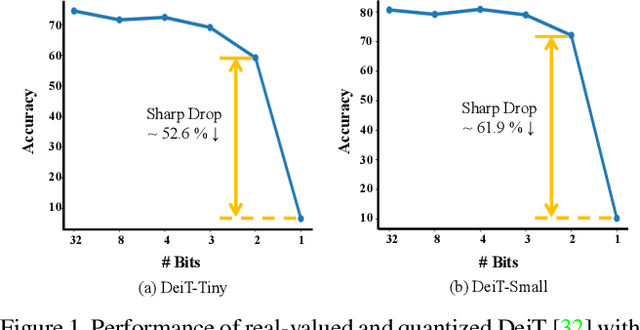
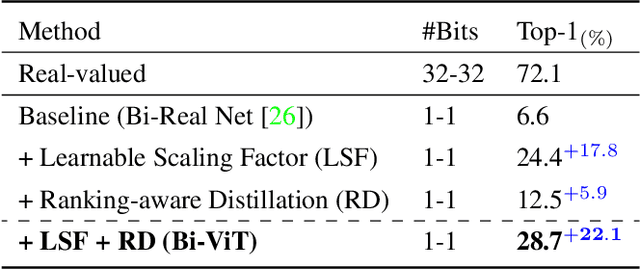
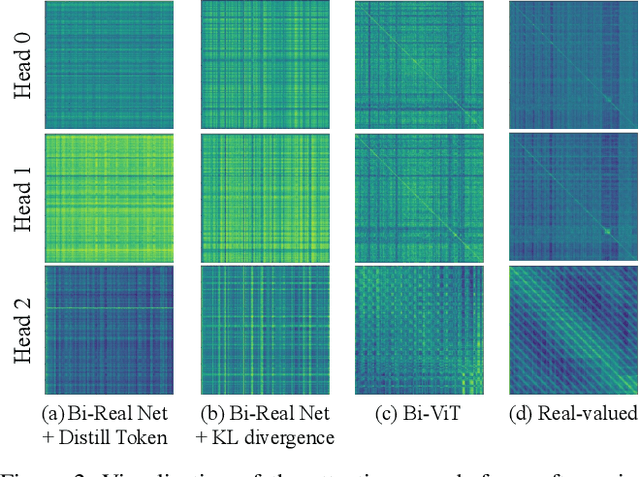
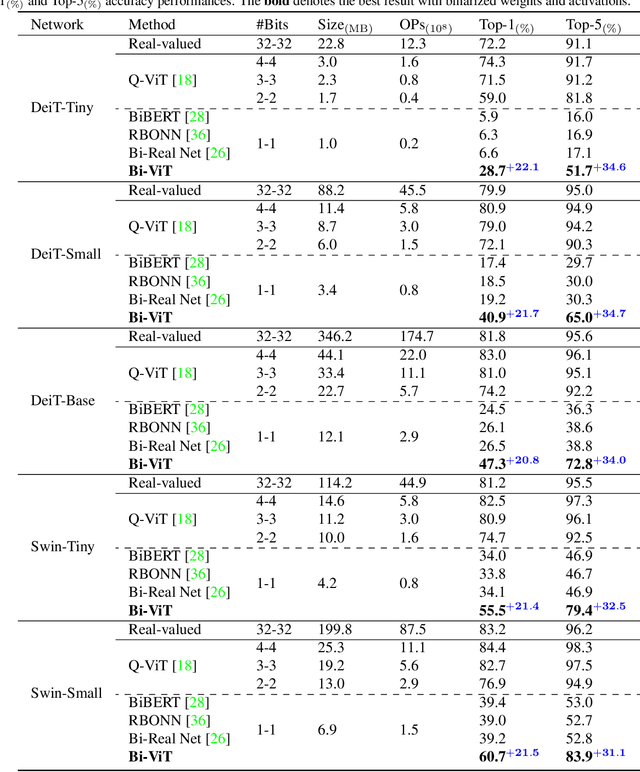
Abstract:Vision transformers (ViTs) quantization offers a promising prospect to facilitate deploying large pre-trained networks on resource-limited devices. Fully-binarized ViTs (Bi-ViT) that pushes the quantization of ViTs to its limit remain largely unexplored and a very challenging task yet, due to their unacceptable performance. Through extensive empirical analyses, we identify the severe drop in ViT binarization is caused by attention distortion in self-attention, which technically stems from the gradient vanishing and ranking disorder. To address these issues, we first introduce a learnable scaling factor to reactivate the vanished gradients and illustrate its effectiveness through theoretical and experimental analyses. We then propose a ranking-aware distillation method to rectify the disordered ranking in a teacher-student framework. Bi-ViT achieves significant improvements over popular DeiT and Swin backbones in terms of Top-1 accuracy and FLOPs. For example, with DeiT-Tiny and Swin-Tiny, our method significantly outperforms baselines by 22.1% and 21.4% respectively, while 61.5x and 56.1x theoretical acceleration in terms of FLOPs compared with real-valued counterparts on ImageNet.
 Add to Chrome
Add to Chrome Add to Firefox
Add to Firefox Add to Edge
Add to Edge